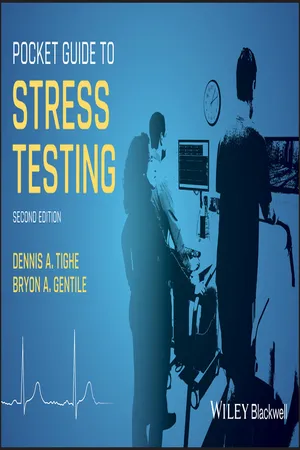
Pocket Guide to Stress Testing
- English
- ePUB (mobile friendly)
- Available on iOS & Android
Pocket Guide to Stress Testing
About this book
The go-to handbook for those performing and analysing cardiac stress tests
The stress test is key to the clinical evaluation and management of patients with known or potential cardiovascular disease. By measuring the heart's ability to respond to external stress, it can provide vital insights into the general physical condition of patients, highlighting abnormalities in blood flow, risk of coronary artery disease, and more. The Pocket Guide to Stress Testing gives cardiology professionals a complete breakdown of this everyday procedure that they can carry with them and consult on the go.
This second edition has been fully revised to reflect the most up-to-date information available on the best approaches to conducting and interpreting various forms of stress test. With chapters spanning topics such as testing guidelines, nuclear imaging techniques, and emergency and aftercare protocols, the clear and practical contents cover all aspects of the subject. This essential new text includes:
- A complete overview of exercise stress testing, covering indications, protocols, preparation, and interpretation
- Guidelines for the standard treadmill test, as well as for the various pharmacological stress tests for patients unable to complete an exercise ECG test
- An extensive list of references and reading suggestions to help trainees to expand their knowledge
- End-of-chapter summaries and new tables and illustrations
As the field of cardiology continues to change and develop apace, this new edition of The Pocket Guide to Stress Testing provides physicians, trainee cardiologists, and cardiac nurses with a reliable, up-to-date resource for use in everyday practice.
Frequently asked questions
- Essential is ideal for learners and professionals who enjoy exploring a wide range of subjects. Access the Essential Library with 800,000+ trusted titles and best-sellers across business, personal growth, and the humanities. Includes unlimited reading time and Standard Read Aloud voice.
- Complete: Perfect for advanced learners and researchers needing full, unrestricted access. Unlock 1.4M+ books across hundreds of subjects, including academic and specialized titles. The Complete Plan also includes advanced features like Premium Read Aloud and Research Assistant.
Please note we cannot support devices running on iOS 13 and Android 7 or earlier. Learn more about using the app.
Information
1
Introduction
Introduction
Pathophysiologic Considerations
- To determine the capability of the coronary circulation to increase oxygen delivery to the myocardium in response to an increased demand. During physical exertion, myocardial oxygen demand is increased by the increase in systolic blood pressure (SBP), contractile state of the heart, and increase of heart rate (HR).
- To assess the exercise capacity. The major factor determining the exercise capacity is the ability to increase the cardiac output; the product of stroke volume (SV) and HR. In normal individuals, cardiac output (Q) typically increases by a factor of four to sixfold from the resting condition to peak exercise. During moderate to high‐intensity exercise, the further increase in Q is primarily attributable to an increase in HR, as SV generally reaches a plateau at 50–60% of maximal oxygen uptake.
Preparations and Precautions
- Report for the test either after an overnight fast or three hours following a light meal.
- Routine medications may be taken with small amounts of water.
- Dress in comfortable clothing and wear comfortable walking shoes or sneakers.
Table of contents
- Cover
- Table of Contents
- Contributors
- Preface
- Abbreviations
- 1 Introduction
- 2 Preparations and Precautions
- 3 Indications
- 4 Contraindications to Stress Testing
- 5 Exercise Stress ECG Test Protocols
- 6 Stress ECG Testing with Nuclear Myocardial Perfusion Imaging Techniques
- 7 Stress Echocardiography
- 8 Pharmacological Stress Testing
- 9 Cardiopulmonary Exercise Testing
- 10 Stress Testing After Acute Coronary Syndromes
- 11 Proper Selection of the Mode of Stress Testing
- 12 Exercise‐induced Cardiac Arrhythmias
- 13 Complications
- 14 Interpretation
- 15 False‐Positive and False‐Negative Exercise ECG Test Results
- 16 Pediatric Exercise Testing
- 17 Follow‐up Care and Management
- 18 Value of Exercise (Stress) ECG Testing Before Engaging in Exercise Programs or Competitive Sports
- 19 Exercise Prescriptions for Healthy Individuals and Cardiac Patients
- 20 Computer Technology in the Field of Exercise ECG Stress Testing
- 21 Medicolegal Aspects of Stress ECG Testing
- 22 Educational Guide for Patients and Families
- Index
- End User License Agreement